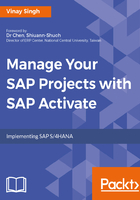
Delta design solution - Workshop type B
From workshop A, the team has realized that some gaps and Delta requirements exist in the project; they use workshop B to achieve the same results. Functional and key users play an important role in the design and acceptance of the Delta solution design. SAP Solution Manager is used as a toolset for solution documentation. To gain business acceptance, the methodology recommends the use of Road Show. Here, the approach is bottom-up; we go to the details and try to resolve it:

Just to bring to the attention of ASAP methodology users: Verify and Accept are not formal blueprint signs; here, it is more about backlog verification and acceptance. After both the workshops are complete in the explore phase, the project team uses this information to conduct release and sprint planning for the realize phase of SAP Activate.
The following are the points to consider before the workshops for fit/gap analysis:
- Set up a reference system (sandbox system) based on SAP Best Practices, RDS, and other references available from SAP.
- Bring real business data into the sandbox system to materialize gap analysis accurately
- Refer to https://cal.sap.com/ and other such application libraries to leverage the prebuild solutions from SAP
- The reference system might not have all the configurations required for the workshop; extending and deploying an additional scenario will help conduct the workshop more effectively
- Discuss and prepare the release and sprint plan for the realize phase.
The SAP cloud solutions are standard solutions preconfigured with SAP Best Practices. The Fit-to-Standard process includes identifying any gaps, as well as cataloging and assigning initial importance and complexity to them:

Let's look at a validate solution example and look at the steps in the journey from the Explore-Realize-Deploy phase:

The following is a summary of the deliverables from workshop A (validate solution). Workshop A starts with meeting with the customer to introduce their business and a detailed workshop plan and preparation. The first demo solution workshop is conducted to validate the process and role, followed by a second solution demo to define gaps and validate process steps. This flow results into:
- A gap list or an updated backlog as a deliverable from workshop A
- An update of the process diagrams by the customer, aligning what has been discussed during workshop
- Decisions, assumptions, and business impacts are well defined and documented
During the preparation for the fit/gap workshop step of workshop A, a statement of work (SOW) is created and stored in the project repository. During solution validation, a process map, business process hierarchy, business process scenario, and scope item process flow are uploaded to the SAP Solution Manager. While the identified Deltas are uploaded into the Solution Manager, key decisions are stored in the project repository.